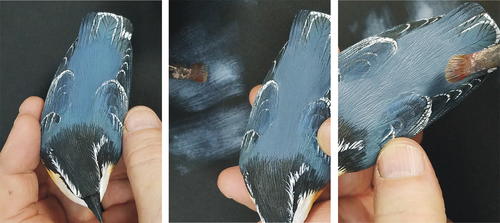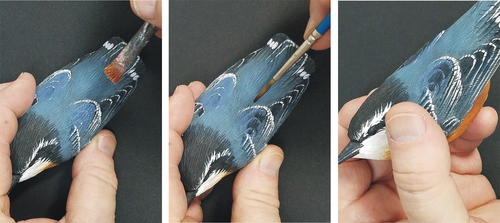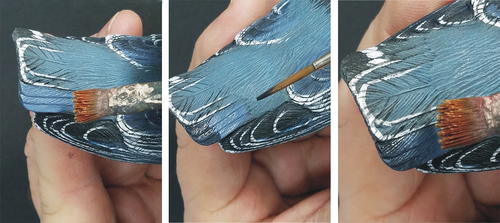Exclusive Excerpt from Three Bird Carving Projects - Part 3

Exclusive Excerpt from Three Bird Carving Projects - Part 3
by Tom Baldwin
Painting & Brushes
I like to start my new students on acrylic paints. That's mostly because acrylics dry fast, which fits better into the lesson time. Acrylic paints are also far less complicated than oil in terms of the media used for thinning and blending. The only real medium needed for acrylics is water. I like to keep things fairly simple, so I will be using only a few basic painting materials for these demonstrations.
Paints
The types of acrylic paints that I use all dry to a dull, or matte, finish. They are DecoArt Traditions, Chroma, and Jo Sonja. They are available from the carving suppliers mentioned in the Materials chapter. You can use the small bottles of acrylics found at the local craft stores, but those colors will not dry with a dull, or non-glossy, finish. If you use those paints, you will need to keep them at a thin or wash consistency to minimize the glossy finish. It is best to get the correct paint.
In the photo above, you can see the five paintbrushes. I will use for the projects in this book. Obviously, I don't spend a lot of money on expensive brushes. The brushes from top to bottom are:
- #8 blender: This brush is about 3/8 of an inch wide. I use it for gesso application and other times when I need to cover up large areas of the carving.
- #6 round: When rolled onto the pallet, this brush comes to a point. I used it when painting a more defined large area, wuch as the primaries, tail feathers, or coverts.
- #2 liner: I use this brush to add small details such as spots and banding details.
- #10/0 liner: This is the workhorse for the final details. Depending on how much paint you leave on the brush, you can paint a detail as wide as 3/32 of an inch or as thin as a human hair.
- #8 blender (worn out): This is one of my favorite brushes. I use it to blend washes or apply a nice dry-brush effect. I use it mostly for blending one color to another.
Color Chart
-
These are all the colors I used for the three different projects.
Types of Painting
-
Dry Brushing
Dry brushing is a very useful technique where you use the texture you etched into the carving to highlight the raised areas of the detail. To do it right, add some paint to the worn-out blender and then scrape off almost all the paint on the pallete. Then you rug the brush over the desired area to get a soft highlight. You do not want your color to fill in the deeper parts of the texture. If if does, you have too much paint on your brush. You will need to pallette it out until it is hardly any paint left. Sometimes my brush is so short of paint I literally scrub the brush over the selected area of the carving to transfer color. -
Wet Blending
You will find that bird carving provides a ton of opportunities to blend different hues. Bird feather colors are often varied and dynamic. With acrylic paint, the blending medium is water. If you want to mix two colors on a tertial feather, take the worn-out brush and wet the surface of the feather until it is a little damp. Take another brush and apply the wash color on the wet surface. Watch the color of the feather blend with the wash color. If you have too much or too little moisture, you will not get the desired blend. Getting the moisture just right takes some practice, but it is not a complicated process. -
Two-Brush Blending
With the two-brush blending method, you want to keep the worn-out brush damp. Wet the surface, paint the two colors you want to blend on the feather, and use the damp, worn-out blender to gently mix the two colors while the paint is still wet. Once the paints dry, you will not be able to blend.
Read NextThe Illustrated Bald Eagle







